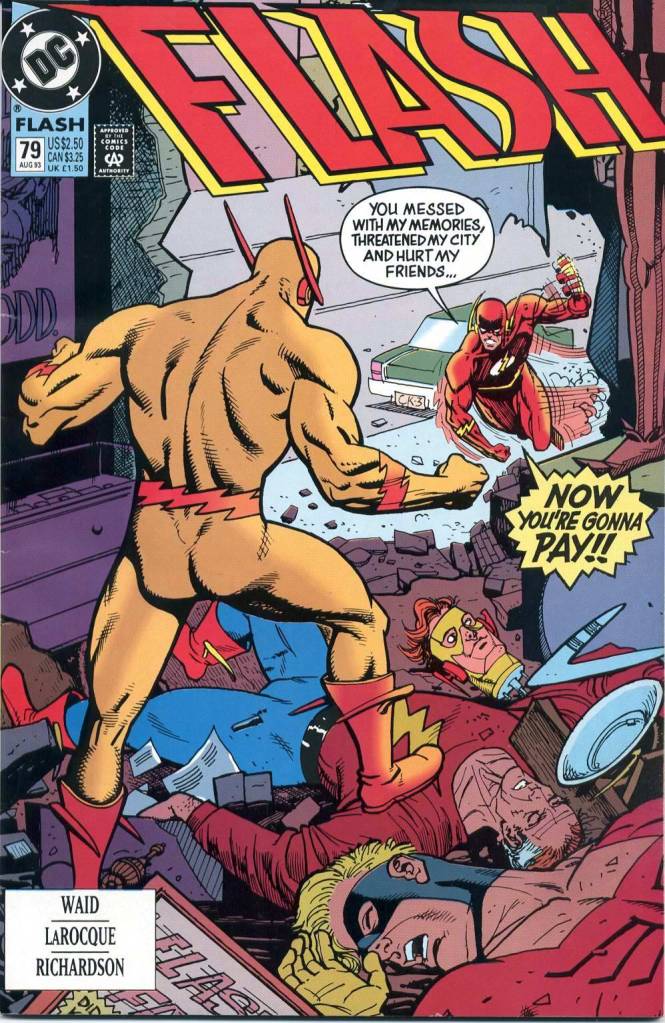
Let’s get this out of the way first: I don’t like the cover. I understand why it was done this way–with his back turned, in the black and white Previews catalog of the era, Professor Zoom would still be mistaken for Barry Allen, his telltale chest insignia hidden. But it’s still an image of a guy’s back. Fortunately, this is the only mishap that FLASH #79 would make. It’s an extraordinary wrap-up to the multi-part “Return of Barry Allen” storyline, and it’s pitch-perfect in how it allows, finally, replacement Flash Wally West to come into his own and step out from the shadow of his mentor.
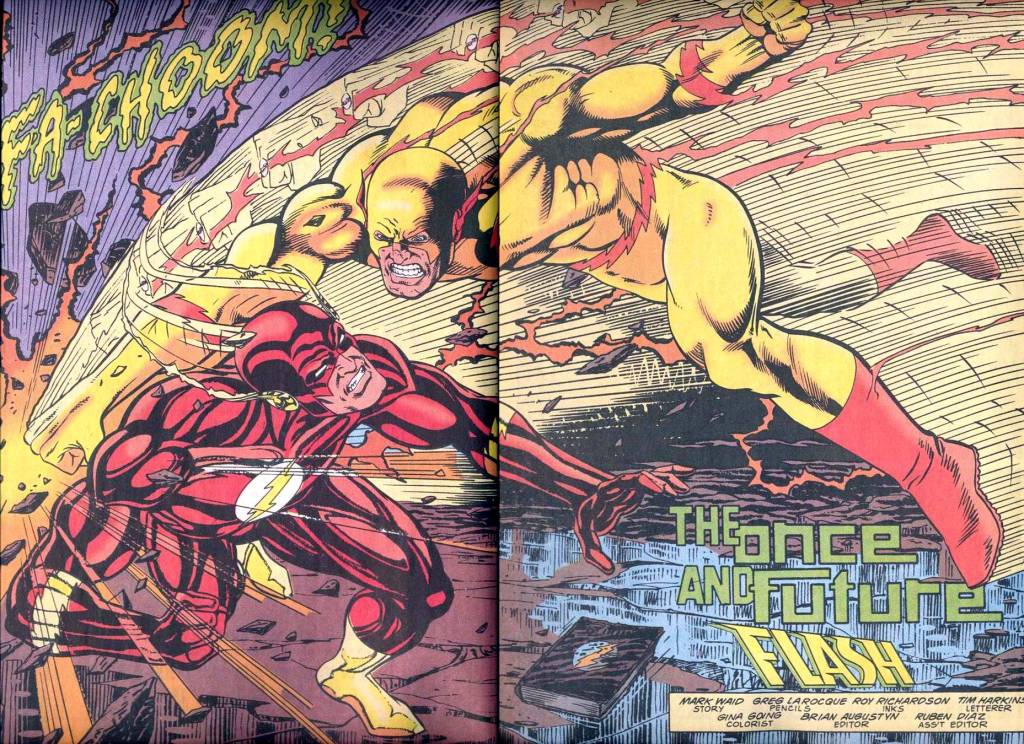
It is also HUGE, a triple-sized issue, all illustrated by regular artist Greg LaRocque, in what would be his swansong after five years on the title. LaRocque was sort of the 90s-modern equivalent of artists such as Dick Dillin or Irv Novick–dependable and reliable, but not spectacular, not the sorts of artists who get fans buzzing. But here, on is final Flash outing, he really brings his A-game.
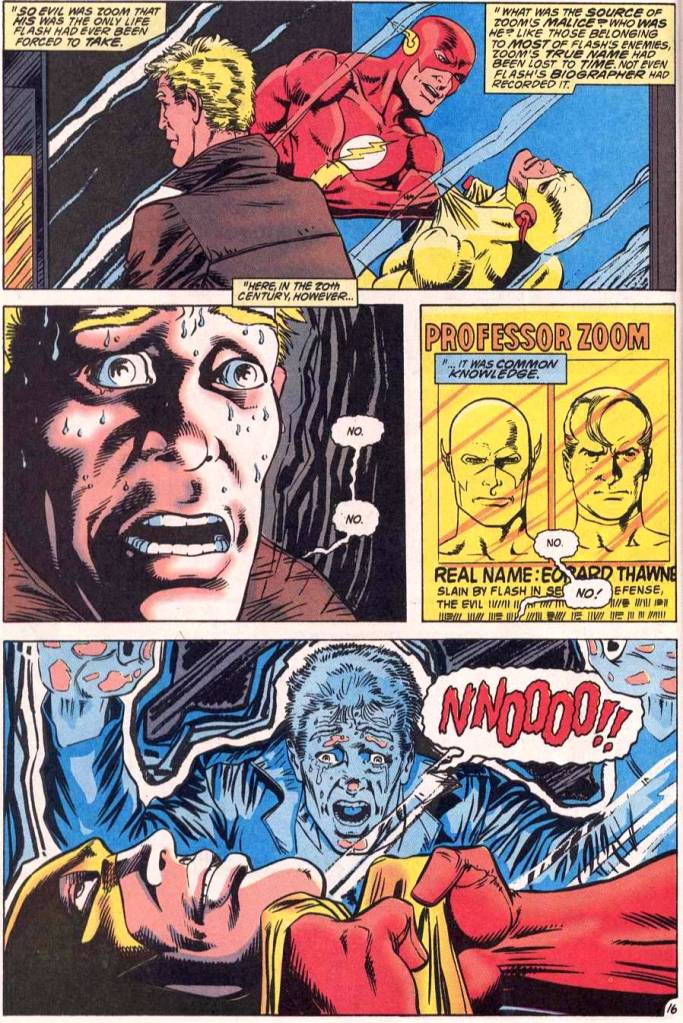
But the real star here is writer Mark Waid, then just beginning his career as a writer. He set up his dominos over the past several issues (with the help of FLASH editor Brian Augustyn, it should be said) and here he proceeds to expertly knock them all over. The big problem that Waid and Augustyn faced on FLASH was the fact that, even though he had been the title character since the aftermath of CRISIS, the audience had still not embraced Wally West as the Fastest Man Alive. Everybody was waiting for Barry’s inevitable return. And so Waid gave it to them–but in an unexpected fashion, and with a couple key twists that made this the perennial Wally West story.

Over the preceding number of issues, Barry Allen had turned up again, alive–the prevailing theory seemed to be that his molecules had been shunted to this time during his suicide run against the Anti-Monitor during CRISIS. But he was back, and as heroic as ever–leaving Wally West, who was still suffering from limitations on his speed, feeling out of sorts and unneeded. Things reach a head when Barry appears to snap, going full rogue–and while Green Lantern, original Flash Jay Garrick, Johnny Quick and new vintage speedster Max Mercury (a character based on Quality Comics’ Quicksilver, but renamed to avoid confusion with the Marvel hero) battle him in the streets, to no avail, a despondent Wally comes across a burned and tattered book in the alleyway where Barry Allen reappeared–a book which reveals his true identity as Eobard Thawne, Professor Zoom, the Reverse-Flash, the only foe Barry had ever killed. So how can he still be alive and taking Barry’s place?
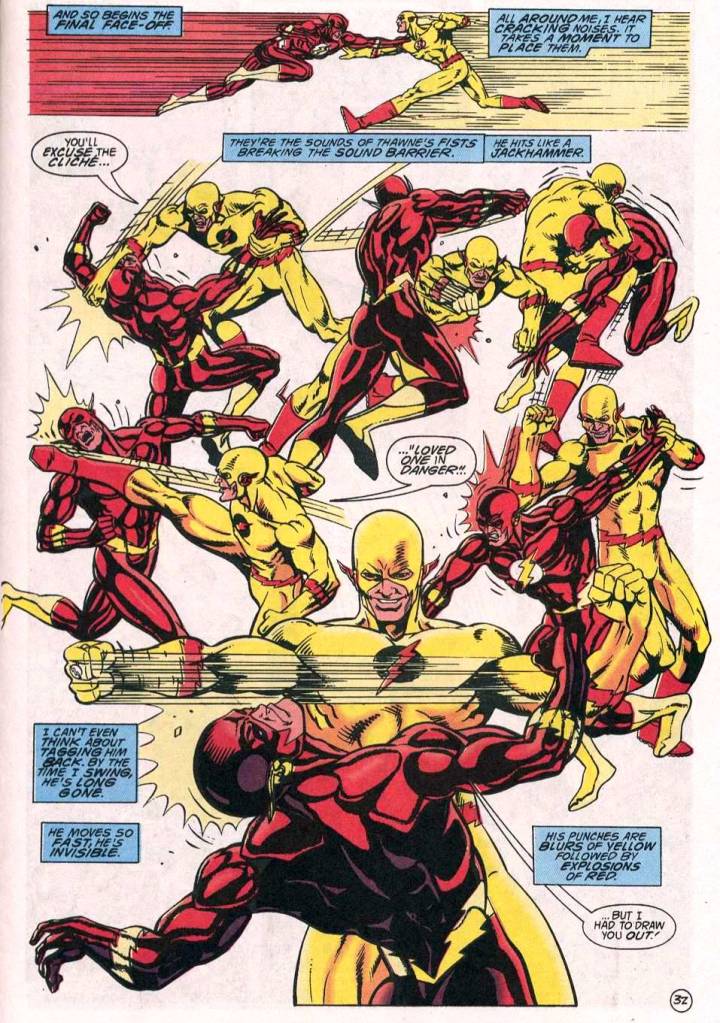
This is really Waid’s master stroke in this storyline. See, Zoom comes from the future 25th Century–and here, we learn that before ever becoming the criminal Reverse-Flash, Eobard Thawne was the biggest Barry Allen fanboy who ever existed. So much so that he had his own features made over to mirror his hero’s, and spent a fortune duplicating the Flash’s powers. This was all in the service of using the Flash’s cosmic treadmill to go back to the 20th century and meet his hero. But after 500 years of disuse, the treadmill functions improperly, depositing Thawne here, where Barry is long dead. And much to Thawne’s horror, he learns that he is destined to become the Flash’s greatest nemesis, and to ultimately die by his hero’s hands. The shock of this revelation causes Thawne’s personality to recede into itself, and he convinces himself that he truly is Barry Allen come back from the dead. In essence, Waid as recast the villain from being a dark mirror of Barry to being a dark mirror of Wally–a corrupt individual who wants to step into the Flash’s boots.

This issue opens with Wally confronting Thawne at the Flash Museum, having restored his memories by giving him his Reverse-Flash costume. As the two combatants circle one another, Thawne gives us his history and backstory, making all of the moments which led us here clear. But it still doesn’t matter–Thawne is still way faster than Wally, and while the kid is able to stop Thawne from destroying the cosmic treadmill (which Wally knows he’ll need to send him back to his correct time) and causing a paradox, he otherwise can’t lay a glove on his opponent, and Thawne proceeds to beat him to a pulp. Wally is only saved by the sudden arrival of Green Lantern, Johnny and Max, but none of them are swift enough to stop Thawne either.
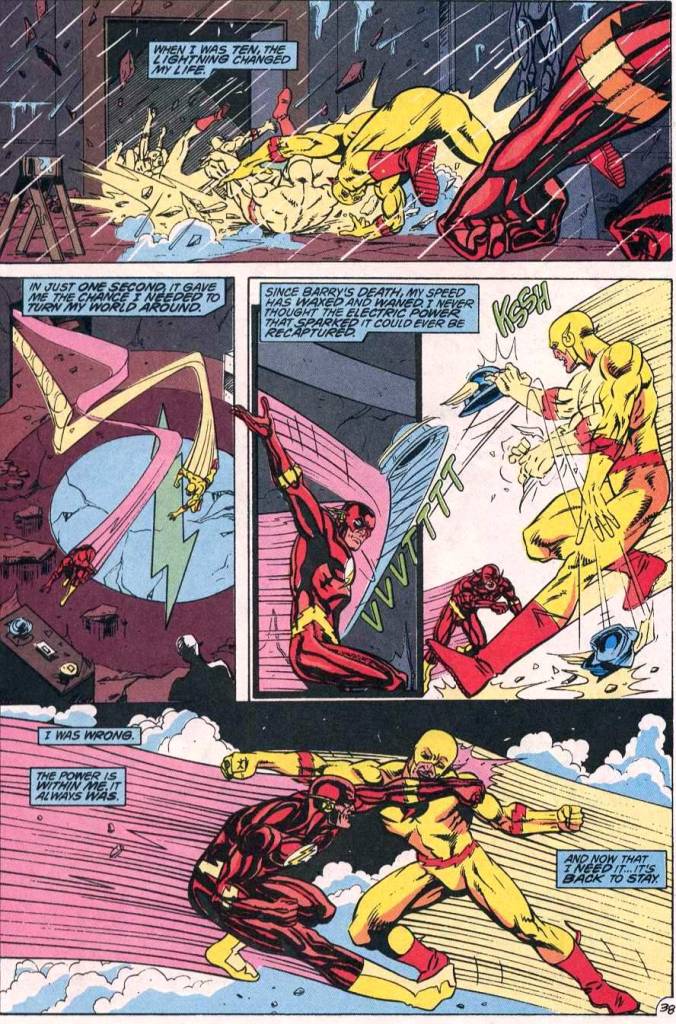
In order to draw Wally out and finish off is rival to the Flash legacy, Thawne attacks the television studio where Wally’s girlfriend Linda Park is a reporter. Wally insists on meeting Thawne alone, that he needs to redeem Barry’s legacy–but e’s still outmatched by the much faster speedster, and he almost given in. But when Thawne goes to far, insisting that he’s going to supplant even Barry’s legacy from the minds of the people of the world, Wally gets mad, and the self-imposed limits set on his power fall away, shattered by his determination to halt Zoom’s rampage. Now, for the first time, they’re fighting on equal footing.
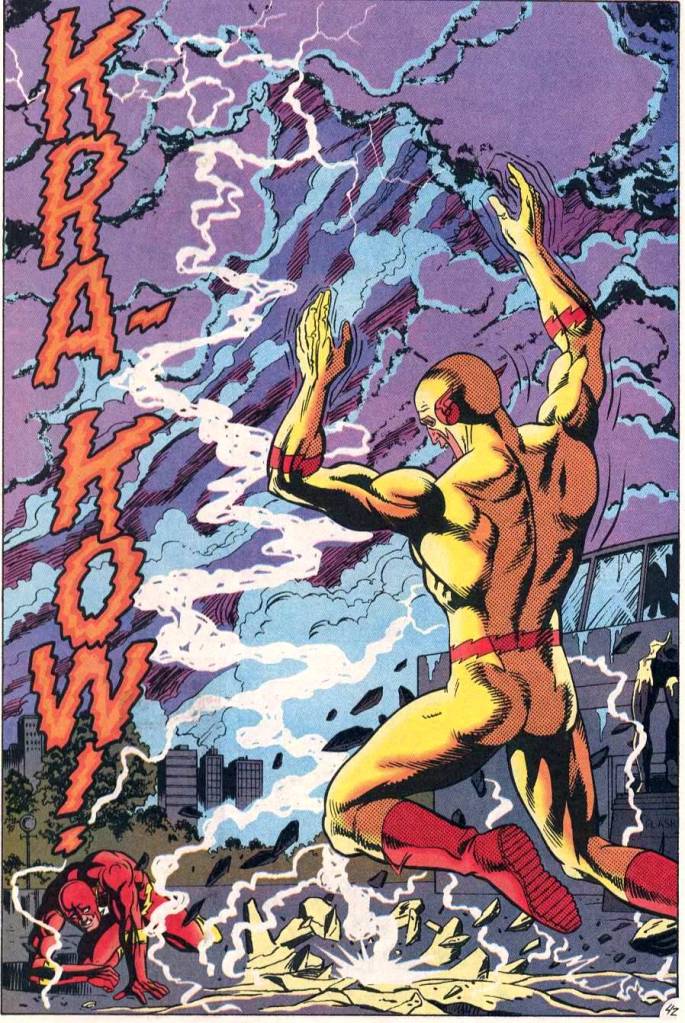
But it’s still a fight–and the two speedsters face off outside of the Flash Museum, in the shadow of the big statue of Barry Allen. It’s a brutal showdown–and at a key moment, Zoom gets the upper hand as Wally slips on the rain-slicked pavement. Zoom is poised to slice him to pieces with hands like buzzsaws–and then, a lightning bolt strikes down on the space between the two fighters, startling Zoom and giving Wally the second he needed to recover. It’s a moment of pure schmaltz, completely unapologetic, but goddamn if it doesn’t work.

From this point on, it’s game over. The Flash has taken his lumps and proven his endurance–now he gets to unload on Thawne both physically and emotionally, and it’s incredibly satisfying. Knowing that they need to maintain the timeline, Wally lures Thawne to the cosmic treadmill and tricks him into using it to return to his native 25th century–where he won’t remember ever having battled Wally West and where his future as Barry Allen’s ultimate nemesis is still waiting for him.

Then, in an extended epilogue, we see that Wally has been embraced as the Flash both by the citizenry–they’ve erected a statue of him next to the repaired statue of Barry outside the Flash Museum–and more importantly in his own mind and heart. Oh, and there’s one more fun beat that Waid gives us. That book that Wally found? It’s a biography of the Flash written several years in the future–and its author is Isis West-Allen, Barry’s supposedly dead wife (killed by Thawne) and Wally’s Aunt. How can Iris still be alive? Well, we comic book readers knew that when last we saw her she was still alive in the 30th century, the era where she’d originally come from. But this revelation promised her return and some great things on the horizon. This last page, where Wally throws away the book that foretells his future, is particularly nice. I ran across the original art to it at a convention several years ago and passed on buying it, a decision I’ve been kicking myself for ever since.
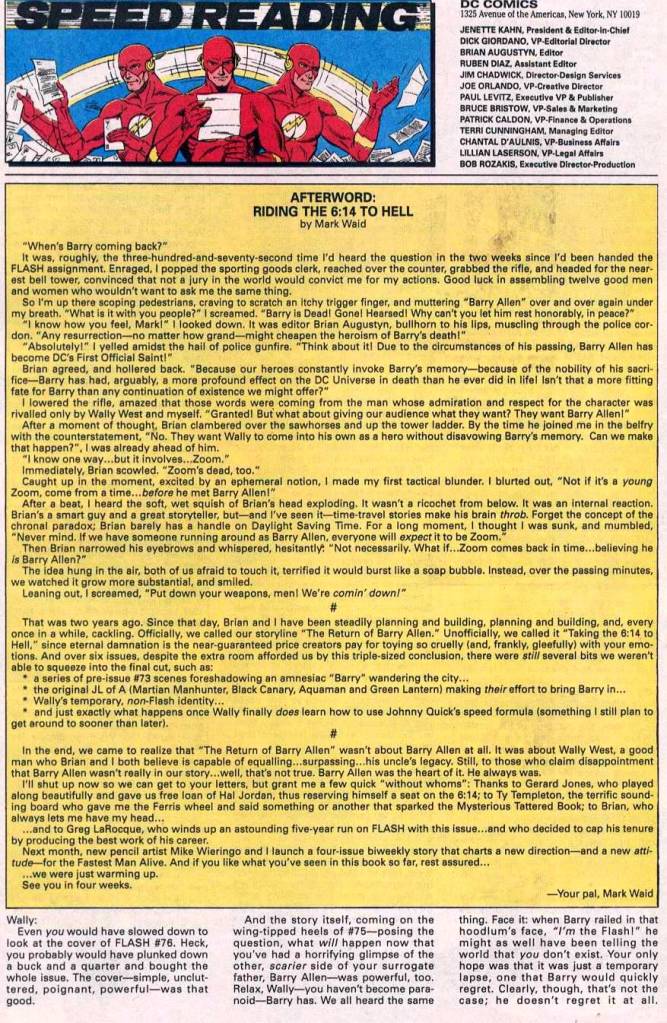
We’ll end here with Waid’s own letters page summation of the storyline he’d just concluded. But this is, in my opinion, the finest single issue of FLASH every produced in the character’s 80 year history.

You’re very kind, Tom. Thank you. Fun Fact for those reading the comments (I’m pretty sure Tom already knows this): the nucleus of this story–What if Barry Allen suddenly reappeared?–actually came long before I was writing the book, when I was starting out by doing Justice League Quarterly stories for Brian. We’d worked out a 30-page story in which “Barry” would reappear, ultimately to be revealed as Barry’s at-that-time-never-introduced grandson, who’d come back to honor his granddad. Thirty pages, done in one. Thank God we didn’t get around to it and instead later split the basic concept into two separate ideas; otherwise, not only would there be no “Return of Barry Allen,” there’d be no Impulse, either!
LikeLike
That was actually my guess as to what was going on as “Return of Barry Allen” was coming out—I had discarded Zoom as a suspect, not because he was dead but because he seemed too obvious.
LikeLike
Also because–and this is the only big flaw in the story–we didn’t even so much as mention Zoom in any way until he’s unmasked, meaning that the reveal wasn’t fair-play to anyone who’d not been a Flash fan for awhile.
LikeLike